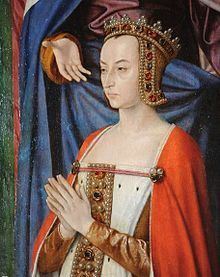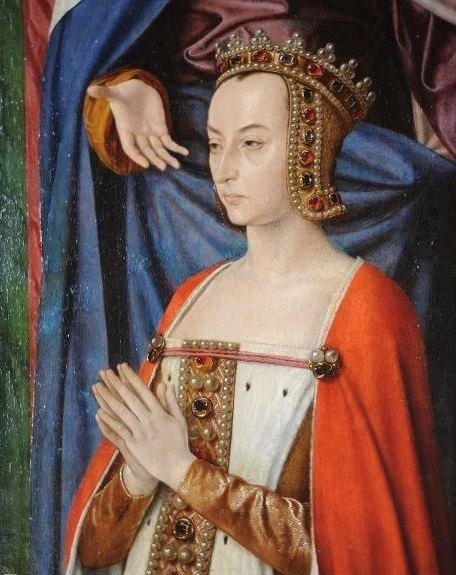Burial Priory of Souvigny Name Anne France | Father Louis XI of France Siblings Charles VIII of France | |
 | ||
Issue Charles, Count of ClermontSuzanne, Duchess of Bourbon Children Suzanne, Duchess of Bourbon Parents Charlotte of Savoy, Louis XI of France Similar People Charles VIII of France, Louis XI of France, Charlotte of Savoy, Suzanne - Duchess of Bourbon, Joan of France - Duchess | ||
Anne of France (or Anne de Beaujeu) (3 April 1461 – 14 November 1522) was a French princess and regent, the eldest daughter of Louis XI by Charlotte of Savoy. Anne was the sister of Charles VIII, for whom she acted as regent during his minority. During the regency she was one of the most powerful women of late fifteenth-century Europe and was referred to as "Madame la Grande".
Contents

Birth and marriage
Anne was born at the Chateau of Genappe in Brabant on 3 April 1461, the eldest surviving daughter of King Louis XI of France and Charlotte of Savoy. Her brother, Charles would later succeed their father as Charles VIII of France. Her younger sister Joan became for a brief period, a queen consort of France as the first wife of Louis XII. Anne was originally betrothed to Nicholas, Duke of Lorraine and was created Viscountess of Thouars in 1468 in anticipation of the marriage. However, Nicholas broke the engagement to pursue Mary, Duchess of Burgundy, and then died unexpectedly in 1473, prompting Louis to take back the fief. That same year, on 3 November, Anne married Peter of Bourbon instead, and took up rule of the Beaujolais at the same time, when her husband was ceded the title of 'Lord of Beaujeu' by his brother the Duke of Bourbon. Anne was just twelve years old at the time.
Regency
During the minority of Anne's brother, Charles VIII of France, Peter and Anne held the regency of France. This regency lasted from 1483 until 1491, and together Peter and Anne maintained the royal authority and the unity of the kingdom against the Orléans party, which was in open revolt during the "Mad War" of the 1480s. As regent of France, Anne was one of the most powerful women in the late fifteenth century, and she was referred to as "Madame la Grande".
Anne's regency overcame many difficulties, including unrest amongst the magnates who had suffered under Louis XI's oppressions. Concessions, many of which sacrificed Louis's favourites, were made, and land was restored to many of the hostile nobles, including the future Louis XII of France, then Duke of Orléans. Louis tried to obtain the regency, but the Estates General sided with her.
She gave her support to Henry Tudor against his rival, King Richard III of England, when he sought her aid to oust Richard, who was deemed by many to have been a usurper. Anne supplied him with French troops for the 1485 invasion which culminated at the Battle of Bosworth on 22 August, where Henry emerged the victor, ascending the throne as Henry VII.
Anne made the final treaty ending the Hundred Years' War, the Treaty of Etaples and, in 1491 (despite Austrian and English opposition), arranged the marriage of her brother Charles to Anne, Duchess of Brittany, in order to annex Brittany to the French crown. When Charles ended the regency in 1491, both Anne and Peter fell victim to the wrath of the new queen, whose duchy's independence had been compromised.
Anne and Peter produced only one surviving child, Suzanne, born 10 May 1491. Anne had an earlier pregnancy in 1476, but about this existed contradictory accounts: some say the baby was miscarried or been stillborn, but others reported that a living son was born, Charles, styled Count of Clermont in 1488 as was customary for the heir of the Duchy of Bourbon, who died aged 22 in 1498 and was buried in the Abbey of Souvigny, Auvergne.
Suzanne succeeded Peter as suo jure Duchess of Bourbon on his death in 1503. Anne, however, had always been the more dominant member in her marriage and remained the administrator of the Bourbon lands after his death, protecting them from royal encroachment. In addition to having had a strong, formidable personality, Anne was an extremely intelligent, shrewd and energetic woman. Her father had termed her "the least foolish woman in France". Anne was dark-haired with a high forehead, a widow's peak, and finely-arched eyebrows. She was further described as having had clear brown eyes, direct in their gaze; a sharp, haughty nose, thin lips, thin hands, and she "stood straight as a lance".
Anne was responsible for the housing and education for many of the aristocracy's children including Diane de Poitiers and Louise of Savoy. She is credited with instructing these young people with the new "refined" manners such as not using their fingers to wipe their noses but a "piece of fabric". Louise of Savoy would act as regent several times when her son Francis was king. By being raised by Anne, she was able to learn about France and its governance from up close. Anne also oversaw the education of Margaret of Austria, who had been intended as a bride for Anne's brother Charles. Margaret would later become Governor of the Habsburg Netherlands.
Suzanne married another Bourbon prince, Charles of Montpensier, who became Charles III, Duke of Bourbon. The couple, however, failed to produce surviving offspring, and Suzanne predeceased her mother. When Anne herself died in 1522, her own line and that of her father became extinct. A descendant of Anne's aunt, Anne of Laval, was considered to be her heir.
Writings
Anne wrote an instruction book for her daughter. It is called Lessons for My Daughter. In it she advises her daughter to surround herself with frugal people and that true nobility comes from being humble, benign and courteous. Absent these, other virtues are worth nothing.
In fiction
A highly fictitious account of her life and her supposed romance with Louis XII was written in 1947 by Muriel Roy Bolton called The Golden Porcupine. As it is a historical romance, the novel cannot be regarded as a biography. Anne also appears as a minor character in Michael Ennis' novel The Duchess of Milan. She plays prominent role in a film Louis XI, le pouvoir fracassé about the last days of Louis XI.
She makes a fleeting appearance in Victor Hugo's Notre Dame de Paris: we are told that in December 1481, the Archdeacon of Josas, Claude Frollo, unsuccessfully attempts to block her visit to the cathedral cloister because she is a woman, then refuses to attend on her visit. The implication is that, already in sexual torment because of the gypsy Esméralda, he fears losing control in the presence of an attractive young woman.
